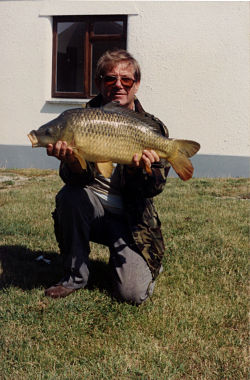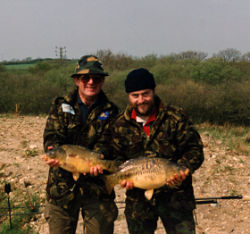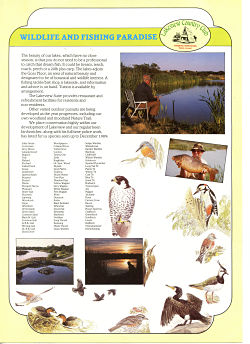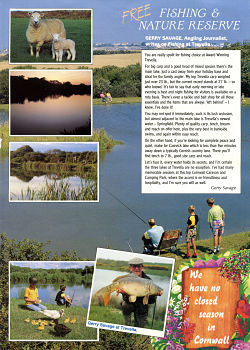Fishing with Gerry Savage, the Cornish years
The radio programme, 'Good Fishing' had been running for a long time and the BBC was looking to change schedules/programming and Gerry was seeking a fresh challenge.
Two new properties were being built just across the road from Bolingey Lake. One had already sold but on selling his house in Kent Gerry managed to secure the other one and so moved to Cornwall in 1987.
Gerry was then involved in a joint venture with John Castle, a fellow Kent carper regarding the purchase of Bolingey Lake. They both recognised the potential in the lake and that between them they could make it one of the top carp waters in Cornwall. Both Gerry and John felt it was too good an opportunity to miss
Lone carper Chris Bannister was a keen Cornish angler, specialising in small water venues. He had devoted his efforts on a small day ticket water throughout the summer and early autumn of 1988, with fish into the upper singles and low doubles but with the suggestions that it held a couple of much larger fish. Rumour proved correct when Chris landed a mirror of just over 20 lb in the early October. After this intense campaign he was in need of a break and some fun fishing, just to put a bend in the rod.
 Chris subsequently had a day at Bolingey carp fishery and a chance encounter with Gerry Savage, who realised that it was Chris who had captured the recent 20 lb fish, which subsequently lead to the formation of one of the most successful pairings in Cornish carp history. When Gerry asked what Chris believed to be the most fundamental factors in catching carp Chris replied “Location, presentation, bait in that order”. There is no point fishing if there are no fish in front of you. Gerry had a very similar approach and said that if Chris took him to the day ticket water, he would take him and fish the Bude Canal, a very unusual carp venue.
Chris subsequently had a day at Bolingey carp fishery and a chance encounter with Gerry Savage, who realised that it was Chris who had captured the recent 20 lb fish, which subsequently lead to the formation of one of the most successful pairings in Cornish carp history. When Gerry asked what Chris believed to be the most fundamental factors in catching carp Chris replied “Location, presentation, bait in that order”. There is no point fishing if there are no fish in front of you. Gerry had a very similar approach and said that if Chris took him to the day ticket water, he would take him and fish the Bude Canal, a very unusual carp venue.
Chris agreed, and on their initial day fishing together the first fish fell to Chris’s rod and was a double figure mirror carp. The second did likewise, and Chris suggested Gerry strike the run and play in the fish. From that time forward, Gerry and Chris fished as a team. The first fish was taken by the rods owner, but from that point onwards, they took it in turns to catch fish. The relationship developed into a father/son or brother/elder brother relationship with Gerry being the more extrovert, the differences in personality adding to the dynamic of their effectiveness as a carp catching unit and also strengthened their close friendship. Enjoying each others’ company they spent time away from the water with their partners sampling good food, live music concerts and social events.
At that time Chris was fishing with self made fibreglass Avon Mk IV carp rods with a compound taper, Gerry was using a pair of 12’ 2lb test curve compound taper rods of his own design which were much better suited to waters of this size, capable of stopping the big fish, but also cushioned fish at closer range to reduce hooks pulling out. They were also capable of casting to a maximum of 100 yards if needed.
Gerry organised a couple of these rods, at a good price for Chris, so they had a matched set of four when fishing together. However, when fishing the larger waters like College and Porth, they upgraded to a 13’ rod 3lb test curve. Chris said how generous Gerry was with his time and experience, running courses for youngsters at Bolingey Lake at weekends and would always be helpful to anyone struggling, giving them bait or guidance. He also bought Chris gold and silver carp badges to celebrate captures of note.
Gerry and Chris were Mitchell reel devotees. With a bolt rig the drag, (now known as a baitrunner), could be applied by simply switching the check off and allowing the reel to run backwards without fear of over-run or tangle. The clutch on the reel would be set to prevent the hook pulling out at close range and any extra drag when playing the fish at range could be applied using the finger pressing on the back of the flyer. They initially used Mitchell 300’s, then 300A’s and finally Mitchell Pro’s although for distance they would use the 13’ rods and Mitchell 300S’s never normally using line over 8 lb breaking strain.
The principle in all their tackle was KISS (Keep It Simple, Stupid) using a simple Nash rod pod, Optonics – no flashing lights, just different tones using the bleep to simply make them aware of the bite. The revolving reel then highlighted what was happening, or in winter, it may have just been the rod tip moving after a solitary bleep.
Chris and Gerry also used to buy tackle from other carp anglers who had left the sport and use any profits made by reselling the equipment to supplement their bait and petrol expenditure.
Due to work commitments, Chris could only fish short sessions of a few hours, and found that he and Gerry had the same philosophy, which proved so vital in these circumstances, focussing on location, then presentation and finally, the bait. Location involved selecting the right water for the conditions on the day and time.
They fished together in the days before mobile phones, and used to telephone each other, often between two and three o’clock in the morning, to finalise the venue based on the prevailing conditions including just looking out of the window. It was uncanny how often both anglers agreed on the appropriate water.
 In summer they would fish with the wind in their faces as any surface food would be carried on a warm surface layer before an undercurrent used to take it down. The fish normally followed this food source. The barometric pressure also affected the results.
In summer they would fish with the wind in their faces as any surface food would be carried on a warm surface layer before an undercurrent used to take it down. The fish normally followed this food source. The barometric pressure also affected the results.
This was not the case in winter where the wind could be an icy blast chilling the water. Here they would use smaller attractor baits, often just breaking up one boillie and then fish tight against the banks, or in places of interest, . One of their favourite baits they nicknamed ‘Christmas cake’ mix. If they could get the fish to mouth the bait, they would catch it.
When fishing Wheal Grey in winter, they would target the old road which was shallower than the rest of the pool, but still over 12 feet deep and warmer in the winter than the remainder of disused and flooded ex-clay pit. If you could find it at 80-85 yards, the fish would be active there. The extreme depth of the pool also added a new dimension as the fish there fought extremely well.
The summer approach was different and they would watch for fish moving, and then fish these areas, rather than the traditional way of fishing a known swim and wait for the fish to move in. This yielded much more rapid results necessary for short session fishing.
Presentation was the next issue. They tried a variety of rigs but eventually developed their own rig which could be used on boillies or particle baits, and proved successful across a variety of waters. This rig remains secret to this day.
Bait was important but wasn’t the panacea. Fish know when food is in the water and will, they believed, take any good quality bait properly presented in the right place; the key was to make the hook bait act in exactly the same way as any free offerings.
They made up many mixes, and rolled their own boillies keeping the kasine protein low, often using bird seed; kelp also worked well. These baits worked over the long term which may probably be due to not being commercially available, and so not being over exposed on any water.
This differed from the standard approach used by most anglers of throwing in 4 to 5kg of groundbait and 200-300 boillies. On these small waters of 2-3 acres, much of the food would still be present when the anglers had left. This is often repeated over successive sessions and led to oversize fish and algal blooms.
Fish now also reached abnormal size due to the amount of high quality feed in the water and have developed distended stomachs, which they both considered very sad. Gerry never wanted to photograph fish he considered bloated or ugly. Gerry had caught 30lb’ers, and Chris 20lb’ers but Chris regarded the size as an ego trip when fish of mid to high doubles normally provided the best sport and were the most attractive with large propellors (tails) and better proportioned bodies.
Carp fishing in Cornwall had largely originated from farm land drainage schemes in the 1960’s with herring bone drains generally leading to a pool of 2 to 3 acres. Farmers at the time could get coarse fish largely for free so stocked the pools with fingerling carp and tench, rather than trout which cost money. These fish, by the 1980’s had become double figure carp which were rarely caught and were pristine timid fish.
When Chris and Gerry approached a new water, they would initially go armed with a float and plummet to find the depth. Gerry also had a knack of being able to tell what the bottom was like by dragging a weight, and this coupled with distance markers on the line allowed the range and size of silt, weed or gravel beds to be plotted giving an overall plan of the water. They also kept detailed records of dates, weather, location on the water, catches, baits, methods etc of all their fishing trips which built into a data base of knowledge which drawn on to make them more effective in the pursuit of their quarry.
It was Gerry’s nature to identify new waters with big fish in. When the Lake View complex was opened, stocked with several twenty pounders (unfortunately the owner, due to his inexperience had purchase old brood fish at the latter stages of their lives) Chris and Gerry targeted the water quickly catching all the big fish whilst they were disorientated which Chris recalls wasn’t particularly hard fishing.
 When Angling Times’ Kevin Wilmott arrived at Lake View to write an article, Chris threw a bait out just a few inches short of an island. Kevin thought it was too close but Gerry and Chris said it was in ‘run city’. The run that resulted produced, at that time, a Cornish record common carp of 26lb 12oz
When Angling Times’ Kevin Wilmott arrived at Lake View to write an article, Chris threw a bait out just a few inches short of an island. Kevin thought it was too close but Gerry and Chris said it was in ‘run city’. The run that resulted produced, at that time, a Cornish record common carp of 26lb 12oz
Together, they did blitz the Bude Canal which was full of double and upper teen Commons in lovely condition. It was in the days when you could only use one rod there. They used to fish across the basins tight to the opposite tow path. Often dropping baits between match anglers! This technique evolved from having noticed that the carp patrol the edge looking for food items dropped by the anglers and tourists right against the bank. They would cast within an inch or two of the bank and use a back lead to overcome the problem of the boat traffic. If there were any features such as reeds, or gaps in reads they would fish there as a focal point for the fish. Chris said they would catch and catch and catch; on one day even packing up because they were so exhausted playing carp which patrolled the banks; there was rarely any reason to move. You hooked the fish against the bank in the ‘killing zone’, and then played them in the main body of the canal away from the taking area, not disturbing the other fish. It was great sport although sometimes the pole anglers got concerned at fish being played adjacent to their swims.
One winter they fished the canal and it was so cold they kept the engine running on Gerry’s Cortina Crusader Estate to keep the heater warm. As the weather got blacker and snow started falling and they hadn’t caught any fish, they headed south along the Atlantic Highway into what had by now become a blizzard. The car was sliding all over the road as the both broke into hysterics knowing that they probably should have been killed. However, they decided not to waste the day entirely and went to Trevalla where they caught fish in slightly less arctic conditions.
 In addition to the holiday camp at Trevella, Trenestral was a two acre pool and part of a drainage scheme and was very hard fishing. The fish had largely become wild and fought tremendously hard having not been caught, especially in weedy water. They fished Trune Farm near St. Keverne which was only 1.5 acres but was well looked after by the farmer who would only allow people he liked to fish it. This held a few 20lb fish
In addition to the holiday camp at Trevella, Trenestral was a two acre pool and part of a drainage scheme and was very hard fishing. The fish had largely become wild and fought tremendously hard having not been caught, especially in weedy water. They fished Trune Farm near St. Keverne which was only 1.5 acres but was well looked after by the farmer who would only allow people he liked to fish it. This held a few 20lb fish
Porth Reservoir was hard fishing but they generally caught carp adjacent to the nature reserve area at night although there were often too many bream.
At College, they used to fish the places that other people didn’t, believing if you can get bait properly presented to a fish in a place that they felt secure, they would feed freely. This caused controversy with people wanting to know what they were doing as they would catch 2-3 fish per session whereas some would only catch 2 fish per week from the regular areas. Chris was never interested in this style of competition, only himself against nature and the carp instincts.
They fished Argyll with success. Chris used to live adjacent to the pool and walk around almost every evening for seven years and in all that time, he and never saw one carp being caught although he and Gerry caught several.
They also fished another water in mid Cornwall that cannot be named was reputed to be a ‘miracle’ water and everybody fishing it was meant to keep secret the size of the fish. The water was built in the middle of a village by ECLP as a village pond which even had ducks on it. The feeder streams carried silt which quickly silted up the pool but created a haven for feeding carp and they grew very big, with possibly a dozen thirty pounders, the biggest in Cornwall. There was a general agreement that pictures of captures should not make the press but one angler asked Gerry to get his picture published. Gerry duly obliged and then got vilified in Carpworld; the angler concerned also didn’t have the courage to admit that it was his request. It was the one time that Chris went into print, and even then people said that Gerry had written the letter and used Chris’s name.
Although Chris and Gerry continued to fish together, and further afield including Devon, they were starting to catch the same fish. This also coincided with a change in Chris’s circumstances and the pair had little opportunity to fish together for several years.
Gerry carried on fishing and writing for papers such as the Cornish Guardian, penning match results and when things were quiet in freshwater fishing, he would write pieces on game or sea fishing.
Chris no longer fishes, happy to study the ghost carp in his garden pool.